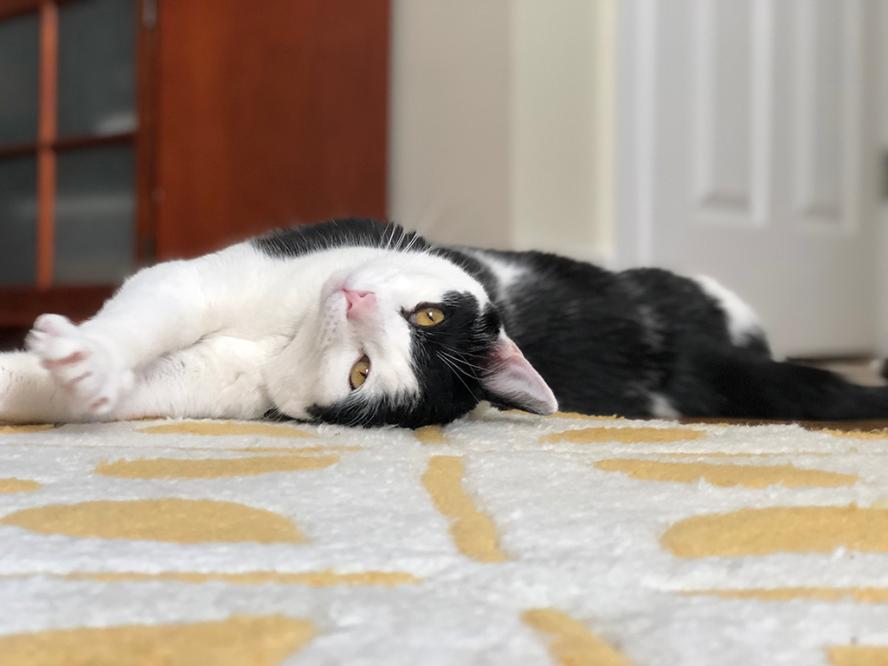-
About
- Leadership & Faculty
- News & Events
-
Academics
- Graduate
- Advanced Clinical Training
- Continuing Education
- Academic Departments
- Academic Offices
- Simulation Experiences
-
Student Life
- Offices
-
Research
-
Hospitals & Clinics
- Emergency Care
- Hospital Services
-
Community Outreach
- Volunteer
More cats with lower urinary tract disease seen at the Foster Hospital during the pandemic
Veterinarians share why being unable to urinate is a life-threatening feline emergency—and how to help keep your pet safe

There’s never a good time for a veterinary emergency, but an ER trip during a pandemic feels doubly stressful. However, Lisa Gallagan knew she had no time to waste when her cat Milton, began acting oddly in late March.
The 6-year-old cat was repeatedly visiting his litter box, where he kept straining but was unable to urinate. “He just looked miserable,” Gallagan said.
It was not the first time that Milton had acted this way. He previously had been diagnosed and treated for feline lower urinary tract disease (FLUTD). Most common in young to middle-aged male cats, this syndrome can cause cats to develop a life-threatening urinary blockage.
Causes of FLUTD include bladder inflammation, urinary tract infections, and bladder stones. Symptoms may include frequent trips to the litter box, crying in pain, excessive grooming, urinating outside the litterbox, and blood in the urine—things that many owners often mistake for a behavioral issue or constipation. As matters progress, an obstruction of the urinary tract can occur. Affected cats are unable to urinate, may stop eating or drinking, begin vomiting, and appear lethargic or very ill.
If a urinary blockage is not treated quickly, a cat can die, said Cummings School clinical professor Mary Anna Labato, V83, a veterinary internist at the Foster Hospital for Small Animals who specializes in disorders of the kidneys and urinary tract. Urinary obstruction can lead to the buildup of toxins normally removed by the kidneys, creating electrolyte imbalances that can result in cardiac arrest. Rarely, the cat’s bladder can rupture due to overfilling. Both complications can be potentially fatal consequences of FLUTD.
Fortunately, Gallagan recognized the signs of FLUTD early and got Milton promptly to the Foster Hospital, where the veterinary team used a catheter to resolve the obstruction. He was hospitalized for two days, after which time Milton was able to urinate on his own and safely return home.
Reducing the Risks of Urinary Obstruction
Since the pandemic began, the Foster Hospital has seen nearly a 40 percent increase in cats being treated for FLUTD compared with the number of cases seen over the same time period last year.
Clinicians are not sure how much of the increase seen at Foster Hospital is due to increased pet stress related to the pandemic. Feline stress is believed to be a significant contributing factor to FLUTD. Cats are thought to be more likely to develop the condition after the arrival of a new baby or puppy, during the hectic holiday season, and when there is conflict or competition between cats in the home.
However, Tufts’ ER overall has been seeing many more cases than normal as a result of area veterinary clinics reducing the number of patients seen due to COVID-19 precautions.
Feline lower urinary tract disease is an extremely frustrating condition for both pet owners and clinicians, said Adam Shoelson, V17, an internal medicine resident at the Foster Hospital.
That’s because “we do not truly understand all the factors that contribute to the underlying disease process,” he said. Additionally, it’s impossible for veterinarians to predict if, or when, another flare-up or obstruction may occur. The condition can become chronic and may require frequent visits to the veterinarian.
With that being said, there are some management strategies for FLUTD that can be employed to reduce the risk of flare-ups. Cat owners can help make their pets less anxious by ensuring that cats have a place to escape for some quiet time away from others in their household. Shoelson said owners also can reduce feline stress by enriching cats’ environment and daily life—ensuring ample opportunities for predatory play and enough resources for multiple cats to enjoy.
This “atmosphere of plenty” should extend to the number of litterboxes, said Shoelson. He noted that there should be at least one litterbox per cat in the home, plus a spare—and that all boxes should be cleaned as frequently as possible. Additionally, dietary management, pain medications, and promoting adequate hydration may play a role in preventing recurrence.
Occasionally male cats need a surgical procedure if their FLUTD leads to multiple episodes of obstruction. Male cats are at a far greater risk than females for developing an obstruction, as their urethra is longer and narrower. Surgery can be performed to change male cats’ anatomy to reduce the chances of recurrent and potentially deadly obstructions. However, the procedure does not guarantee a cure and can create other serious complications, so Labato recommends that cat owners try the previously mentioned preventative measures first.
Once a cat develops FLUTD signs, it is imperative for the owner to monitor its urine output closely. This can be tricky, especially in multiple-cat households. Any cat with symptoms of a possible obstruction should be immediately assessed by a veterinary professional.
Veterinarians may send cats that have an uncomfortable bladder without evidence of obstruction home on medications to see if they can recover in a less-stressful environment. However, if a cat is unable to urinate comfortably within eight to twelve hours, it should be evaluated again to make sure there has not been a turn for the worse.
Such was the case for Milton. His owner, Gallagan, followed her veterinarian’s instructions to seek emergency care if the medications prescribed to help Milton pee did not do the trick.
Today, Milton is happily back to normal, Gallagan said. “He’s enjoying napping most of the day and being very affectionate and social.”
Department:
Foster Hospital for Small Animals